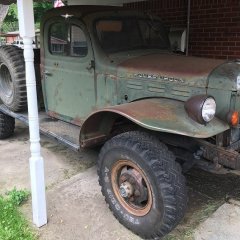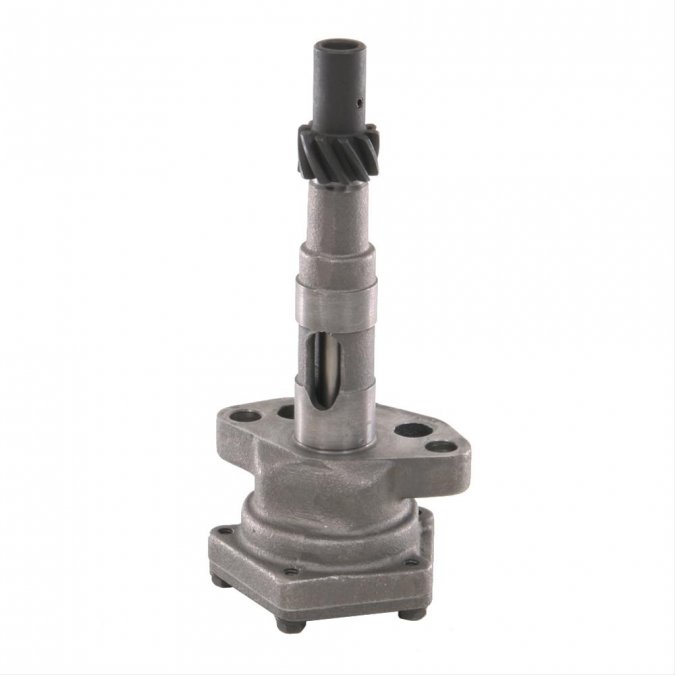-
Posts
51 -
Joined
-
Last visited
Everything posted by thisoldtruck
-
Good old fashioned molasses mixed with water works very good too. Works on most rusted parts as well. Takes forever though, like two weeks if the parts are rusted really badly! But it does work really well.
-

heads, combustion chambers, compression ratio
thisoldtruck replied to kencombs's topic in Technical Archives
Wow! I don't know if I'd want to remove 100 thou from my head on the 251 engine, but it looks like that's what they can do on the Chrysler 6s. But what's interesting is only 65 thou on a DeSoto head. I really wonder about head part numbers/casting numbers and the differences between them. I know that the part numbers for the two heads available in the 1960s Dodge trucks was: 2202771--Internal by pass, low compression ratio 6.4 to 1 2264240--External by pass I'm not sure on the industrial engines. That would be interesting too. -
The following came from a Chrysler technical reference manual and is, I believe, the answer to the OP question: THE COOLING SYSTEM One of the complaints most frequently heard during cold-weather operation is in relation to the engine cooling system and the performance of the car heater. Therefore, a review of some of the fundamentals of the cooling system may prove helpful. Heat developed within the engine is converted to mechanical energy to operate the engine. Not all of the heat is used for that purpose, however. Some heat is given off through radiation, and some is carried away by the exhaust system. The balance of the heat not used to operate the engine is carried away by the cooling system. In other words, the cooling system is carefully designed to control the operating temperature of the engine for its most efficient performance, and to carry away the excess heat. If the engine runs too cool, the fuel mixture won't burn completely. Some of it will find its way down the cylinder walls and into the crankcase where it dilutes the oil and helps to form acid. If the engine cooling system is not adequate to carry away the excess heat, the engine will run too hot. The coolant will boil, and engine damage may occur. THERMOSTAT The thermostat has a very important job to do. It must stay closed when the engine coolant is cold, permitting circulation of the coolant within the engine and thus provide a short warm-up period. Then, when the coolant has reached operating temperature, the thermostat must open and permit coolant circulation through the radiator. Starting with the 1960 models, all engines have a 180-degree thermostat as standard equipment. This means a permanent-type antifreeze must be used in the cooling system. If an owner wanted to use an alcohol-base antifreeze he would have to install a 160-degree thermostat. Some technicians believe that different thermostats should be used for summer and winter operation, on the theory that overheating is less apt to occur in hot weather with a 160 degree thermostat. This is not true. Engine cooling is just as effective with a 180-degree thermostat as with one which opens at 160 degrees. Therefore, changing thermostats twice a year is an unnecessary inconvenience and expense. If abnormal conditions are encountered, and the coolant temperature rises above 180 degrees, the thermostat will be fully open regardless of whether it is a 160-degree or a 180-degree thermostat. This means the maximum cooling will take place with either thermostat, and the possibility of overheating is no greater with on than with the other."
-

Slight Engine Modifications
thisoldtruck replied to thisoldtruck's topic in Mopar Flathead Truck Forum
No, I mean actually making a version with DOHC that supposedly used two separate timing chains to drive each cam shaft. I saw pics of one of the later V8 versions with DOHC that used one timing belt to drive both cam shafts. That too was a display engine. But not to be confused with the inline six version. -

Slight Engine Modifications
thisoldtruck replied to thisoldtruck's topic in Mopar Flathead Truck Forum
So the engine in the original post above did actually run then? I’ve heard they made a DOHC version of it, which to me would make more sense from a practical point of view then with using push rods and lifters. -
Yes, the oil cooler will extend the life of the oil and thus extend the service life of engine. The trans cooler is too big for these engines, think something like a power steering oil cooler in size. Put the thermostat close to the engine as possible. All the new v6 and 4 cylinder Mopar cars come with oil cooler installed on engine now. It’s not just for heavy duty applications, it’s for engine longevity. In my 2014 Dodge Journey I’ve got the 3.6 liter vvt engine and it uses a water to oil cooler incorporated into the oil filer housing.
-

Slight Engine Modifications
thisoldtruck replied to thisoldtruck's topic in Mopar Flathead Truck Forum
They must have had a hole drilled at angle through the block to run push rod up to the other side. But then there is the water jacket issue as well. That looks like the oil filter on the manifold side of the block as well, so they must have ran different oil passages throughout the block. I think the pressure angles on the push rods/lifters/valves would have been great, maybe too great. Andy -
Somebody in the aftermarket crowd really needs to jump on this! I know I would slap it on my 251 if it were available!. Seems to be a modified 265 though. Andy
-
Now if you put the spark plug ahead of those, I'll bet those would make a swirl effect to the flames shooting out back!
-

Sticking valve in a rebuilt motor
thisoldtruck replied to 41/53dodges's topic in Mopar Flathead Truck Forum
I got the same manifolds on my 251 in my power wagon. I've got an industrial 251 in my truck though. Yours has the heat riser valve, mine does not. I'm thinking of modifying it as it would help in winter startup and driving. I also need to drill a couple of extra holes in the intake manifold for the windshield wipers and brake booster. -

Sticking valve in a rebuilt motor
thisoldtruck replied to 41/53dodges's topic in Mopar Flathead Truck Forum
Yes, Marvel Mystery oil is good. I've used it in the gas for top cylinder lubrication. Even poured some down the spark plug holes and the carburetor. For long term storage, I use a can of fogging oil. -
My thought is, if you have an engine that has a sludge problem, it's time to pull it out of the truck/car and take it apart and clean and check EVERYTHING! Replace what's worn, which I'm sure there will be plenty that's worn.
- 8 replies
-
- engine oil
- 20
-
(and 1 more)
Tagged with:
-
Please don't miss understand. Keep in mind, most of the stories I heard about the 230s and M37s were from people in the military during Vietnam, like from 1966 to 1972. The M37s were old by then and I think that had more to do with it then anything else. Plus during combat, who knows what happened to these trucks exactly. I think diluted engine oil was a big cause of spun bearings. Looking at all the engines made by different manufactures during the 1930s through the 1950s, I would say Chrysler had the best of the best! I've heard a lot more unfortunate stories with Ford flat head eights, like cracked block stories.
-
I'm gonna guess that the trucks probably stopped using it by 1972 model year. I know my 1971 W200 had it, but my 1975 W100 had electric washer. The cars always seemed to get the high tech gadgets first at Chrysler it seems during these years. I think all the cars were electric by 1967 though. I had a 1966 Dodge Coronet 500 two door hardtop that had electric washer. The washer bag used in my 1966 WM300 is still manufactured today! They are used in the Abrams tanks. But they don't say Mopar on them or Jiffy Jet either like the originals.
-
On my truck, I have the rubber foot pump. Next to the head light dimmer foot switch.
-
I heard back in the 1930s, 1940s and into the 1950s they would pick an engine from the line and test it for the 50 hour test and run it at 3600 rpm. It was sort of random quality controlled type test on an engine test stand next to the assembly line at the engine plant. These tests were on all the flat head six engines, either 23" or 25" blocks. I've heard of a guy drag racing Mopar flat head sixes back in the 1950s that supposedly ran them as high as 5,000 rpm. Not sure of what engines he used. But could never confirm that story. There are many stories of M37s spinning rod bearings on the 230s back in the 1950s and 1960s as well.
-
I’m curious about this too. The larger block engines, 25”, still used the 1” size. Andy
-
I don’t know about the Pilothouse trucks, but on the PowerWagons, they also had a ground strap hooked from engine block to cab body/firewall. Andy
-
Sorry to hear Don. My Grandpa is going through the same thing right now. Although he had one of his carotid arteries blocked back in May, he just recently had a series of mini strokes just the other day. If you keep fighting, you might regain some of the lost functions back. Keep challenging your left side.
-
Basically he was 2 strokes away from TDC on cylinder number 1 and cylinder number 6 already fired and was in process of exhausting itself, so cylinder number 2 would be next in line for firing right at this stage. Whatever state number 6 is in, really doesn't matter because cylinder number 5 is next to fire after cylinder number 1 anyways.
-
I would only pay attention to cylinder number 1. As mentioned, it takes two revolutions of crank shaft to complete cycle. So intake valve opens as piston drops, to let air/fuel into cylinder, then intake closes and piston starts to come back up. When piston is at top, that is top dead center and ready to fire that cylinder.
-
I thought people also used rotors from a 1976-1980 Plymouth Volare?
- 10 replies
-
- disk brake conversion
- hub size
-
(and 2 more)
Tagged with:
-
That's exactly the PCV valve system on my truck! All the Power Wagons were set up like that. I don't know what that thing is either on the radiator hose in the first video. The main reason was most of the time, the truck stayed stationary and didn't move while the engine ran providing power for some application, so a draft tube would be worthless ventilating the crank case. The M37 were designed to ford in 28" of water, and with little modifications to ignition system, a civilian truck could do the same.. Now, the Power Wagons also used a very similar PCV valve for power brakes hooked to the power brake booster as well.
-
The only trouble I could really see come from this, if the oil pump and distributor weren't indexed correctly, is that when you adjust the timing on the distributor while rotating, you could end up having to turn the distributor so then that the vacuum advance goes into the engine block, which would suck.
-
Here's a picture of the oil pump. The drive gear is attached to it and the distributor slot shaft slips into the top.





